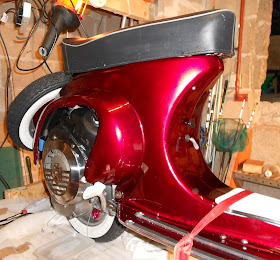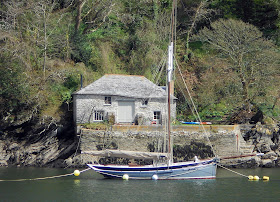isn't as easy as it looks, especially if you have no idea what you are doing! But, we are persevering and dedicated and so 'Stacey' slowly makes progress. Today we have had some quality father/son time restoring her a little more.
The petrol tank valve got sorted and twisted to the correct position. The petrol tube from the carb was attached and the tank installed in the frame. We haven't tested it yet for leaks but will do so next weekend.
In a moment of sheer inspiration, number 1 son installed chrome trim around the front mudguard and what a transformation that made. It also resulted in the decision that all edging will now be finished in fore mentioned trim!
The seat was given some elbow grease scrubbing with CIF cleaner and has come up a treat and that was installed but not before said son had put it on a chair in the kitchen, sat on it and made 'brum, rum' noises loudly whilst imaging that he had a set of handlebars in his hands and was revving the throttle. He is revising for GCSE's so we have to make little allowances for his mental state!
The troublesome steering fork was dropped (again!!) and the bearing races removed to be replaced with individual 4mm and 8mm ball bearings. We had lost some of the original ones when disassembling but managed to finally track down a supply. And what a difference that made. The steering tightened up completely - no rattles, no rocking. Tight! Which is great except that it seems to have bought the mudguard awfully close to the legshield and whilst the wheel can be turned easily from side to side without scrapping said legshield or protruding nuts.....it does seem awfully close doesn't it! Too close perhaps?
Anyway we have returned to the two forums (smallframes proboard and the Vespa Club of Great Britain) to ask the experts what they think. They have saved us time and time again and I'm sure they will now.
We've started tackling the headset. The white rubber throttle and gear grips are on; the throttle tube has been inserted into the headset. The gear tube would have been until we discovered we are missing a white rubber washer - how irritating!
So...we are making progress. Our aim is to have her complete for half term in 6 weeks time when we will try and start her up all being well.
Steve
The petrol tank valve got sorted and twisted to the correct position. The petrol tube from the carb was attached and the tank installed in the frame. We haven't tested it yet for leaks but will do so next weekend.
In a moment of sheer inspiration, number 1 son installed chrome trim around the front mudguard and what a transformation that made. It also resulted in the decision that all edging will now be finished in fore mentioned trim!
Even I have to admit 'Stacey' is beginning to look classy and
I am very proud of number 1 son (well only son)
I know son would like a white seat but he will have to save up or get a job for that one
The troublesome steering fork was dropped (again!!) and the bearing races removed to be replaced with individual 4mm and 8mm ball bearings. We had lost some of the original ones when disassembling but managed to finally track down a supply. And what a difference that made. The steering tightened up completely - no rattles, no rocking. Tight! Which is great except that it seems to have bought the mudguard awfully close to the legshield and whilst the wheel can be turned easily from side to side without scrapping said legshield or protruding nuts.....it does seem awfully close doesn't it! Too close perhaps?
So what do you think.....too close?
Anyway we have returned to the two forums (smallframes proboard and the Vespa Club of Great Britain) to ask the experts what they think. They have saved us time and time again and I'm sure they will now.
We've started tackling the headset. The white rubber throttle and gear grips are on; the throttle tube has been inserted into the headset. The gear tube would have been until we discovered we are missing a white rubber washer - how irritating!
It was so long ago we took all this apart that we can't quite work out what way the throttle cable pulley goes back in - well dur!
So...we are making progress. Our aim is to have her complete for half term in 6 weeks time when we will try and start her up all being well.
Steve

















































